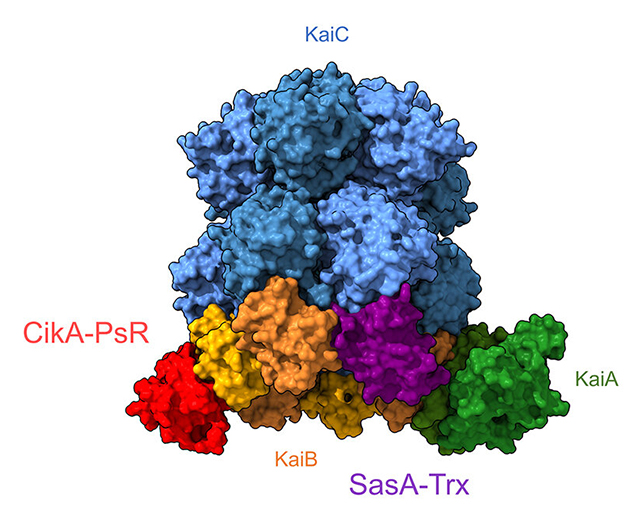We all have a built-in clock telling us when it's time to eat, time to sleep, and time to get up and do something with the day. Many organisms do, in fact, which is why it's such an important area of research for scientists.
Now the circadian clock and its responses to environmental cues has been studied in a way that has never been done before. Scientists were able to track the clock and its functions in real time, using a tiny aquatic organism called a cyanobacterium (Synechococcus elongatus). Given its clock works in a similar way to ours, it can tell us a thing or two about our own daily rhythms.
The team looked at the cyanobacterium's core oscillator – a nanomachine powered by three proteins that acts as a time regulator – studying the ways its output acts as a signal for timekeeping. The core 'oscillates' in response to different signal molecules binding to it throughout the day, resulting in the rhythmic expression of hundreds of genes within the cyanobacteria.
The new study analyzes how these interactions change when the cyanobacterium's clock 'resets' at the molecular level, something that could be compared to jet lag or daylight saving time adjustments for humans.
"We used in vitro clock reactions and performed massively parallel experiments to study entrainment, the synchronization of the clock with the environment, in the presence of output components," the researchers write in their published paper.
The research builds on an in vitro clock some members of the team had previously developed, one that could operate inside a test tube. Through new advancements in the way the clock is monitored and run, the team was able to get real-time readings as the timing settings were adjusted and responded to.

This revealed several new insights, including the fact enzymes known as kinases that mediate genetic expression are more closely related to the clock function than previously thought.
"For the first two decades after its discovery, most of the research has been centered on the core oscillator," says biochemist Mingxu Fang, from the University of California San Diego (UC San Diego).
"We now find that the kinases, previously thought to be just output components, are actually part of the whole clock."
The core oscillator is often thought of as the 'gears' of the circadian clock and the kinases as the 'hands', with both required to tell the right time. What this study shows is how they're both needed – and how closely linked the inputs and outputs of the clock are.
"We now know that the hands of the clock are actually part of the time-keeping mechanism," says molecular biologist Susan Golden, from UC San Diego.
"If you don't have both hands they don't set time correctly because one of them is a stabilizer and one a perturber to the resetting signal, and you need both."
To put it another way, in retrieving information from the clock, the kinases also interfere with it. It was also shown that two kinases are needed to properly respond to a 'reset' signal, as might happen when we move through time zones.
Now that this method of real-time monitoring has been established, it can be used to better understand how our own internal circadian rhythms work, and how their timekeeping has an effect on the rest of our bodies.
The research has been published in PNAS.
